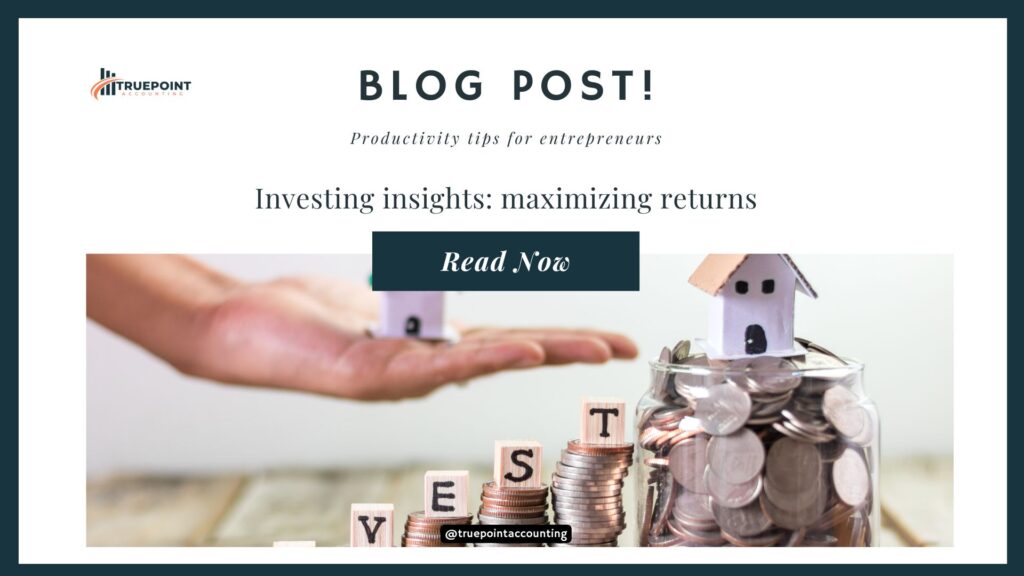Investing insights: maximizing returns in today’s market landscape

In today’s fast-paced and unpredictable market, investing requires a blend of strategy, adaptability, and awareness of current trends. With the economy and stock market facing continuous shifts, maximizing returns means understanding key investment principles, managing risk, and staying informed about emerging opportunities. Here are some essential insights to help investors navigate today’s market and optimize their returns.
Profit in business comes from repeat customers, customers that boast about your project or service, and that bring friends with them.
– W. Edwards Deming
Diversify Your Portfolio
Diversification is one of the core strategies for managing risk and achieving stable returns. A diversified portfolio spreads investments across various asset classes—such as stocks, bonds, real estate, and commodities—to reduce exposure to any single market segment. This approach provides a cushion if certain assets underperform, as gains in other areas can help balance losses. Additionally, global diversification—investing in markets outside your home country—offers exposure to different economic conditions, further reducing risk.
Focus on High-Quality Stocks
In volatile market conditions, high-quality stocks tend to perform better over the long term. Companies with strong balance sheets, consistent earnings, and a history of weathering economic downturns make more resilient investments. Blue-chip companies, those with established reputations and market leadership, offer more stability compared to smaller, high-growth stocks. While these high-quality stocks may not always provide explosive growth, they offer reliable returns and can act as a strong foundation within a balanced portfolio.
Embrace Dollar-Cost Averaging
One way to mitigate the risk of market volatility is through dollar-cost averaging, a strategy that involves investing a fixed amount of money regularly, regardless of market conditions. By consistently investing, you buy more shares when prices are low and fewer when they’re high, effectively lowering the average cost per share over time. This approach reduces the impact of market fluctuations on your investments and encourages a disciplined, long-term outlook.
Stay Informed About Market Trends
Keeping an eye on market trends is essential for making timely investment decisions. Currently, sectors such as technology, healthcare, and clean energy are experiencing substantial growth. Tech continues to thrive with the increasing role of AI and digital services, while healthcare innovations and the rising demand for sustainable solutions position clean energy as a promising long-term investment. By understanding which sectors are gaining momentum, you can align your investments to capitalize on industry growth trends.
Prioritize Tax-Efficient Investments
Maximizing returns isn’t just about making money—it’s about keeping more of what you earn. Tax-efficient investing strategies can help you minimize your tax liability, leaving more profit in your pocket. For example, consider holding long-term investments to benefit from lower capital gains tax rates. Tax-advantaged accounts, like IRAs and 401(k)s, allow for tax-deferred or even tax-free growth, depending on the account type. By managing tax exposure, you can make the most of your investment returns.
Consider Alternative Investments
Today’s investors are increasingly exploring alternative investments like real estate, private equity, and even digital assets like cryptocurrency. Alternative investments offer portfolio diversification and can deliver substantial returns that aren’t necessarily correlated with the stock market. However, they come with unique risks, such as illiquidity and higher fees. Before adding alternatives to your portfolio, ensure you understand the specific risks and potential rewards involved, and consider allocating only a small portion of your portfolio to these assets.
Manage Risk and Stay Flexible
Risk management is crucial in a rapidly changing market. While it’s tempting to chase high returns, it’s equally important to understand and mitigate potential downsides. Setting stop-loss orders, regularly rebalancing your portfolio, and avoiding overconcentration in high-risk assets are ways to limit potential losses. In today’s market, flexibility is also key—being willing to adjust strategies as conditions change can help you navigate uncertainty more effectively.
Take a Long-Term View
While short-term gains can be enticing, focusing on long-term growth often leads to greater success. Market volatility is a given, and reacting impulsively to short-term downturns can result in missed opportunities. Investors who take a long-term view are better positioned to weather market fluctuations and benefit from compounding growth. Patience and consistency often pay off, particularly in uncertain times.
Work with a Financial Advisor
For those who feel overwhelmed by the complexities of today’s market, consulting a financial advisor can provide clarity. Advisors offer tailored insights based on your goals, risk tolerance, and financial situation. They can help you craft a strategy that balances growth and stability, and they stay updated on market changes that might affect your investments. With professional guidance, you can make more informed decisions and optimize your portfolio for long-term success.
Final Thoughts
Maximizing returns in today’s market landscape is achievable with a well-informed, strategic approach. By diversifying your portfolio, focusing on high-quality assets, and considering tax efficiency, you’re better equipped to navigate market shifts. Staying informed about trends, managing risk, and maintaining a long-term perspective can ultimately lead to greater financial success.
4o
